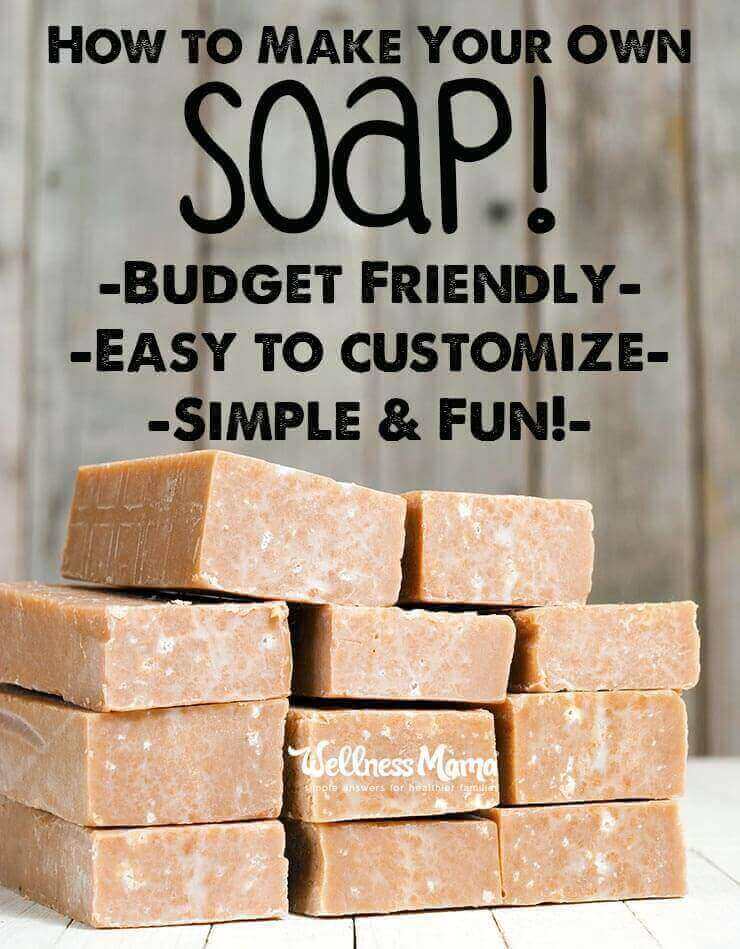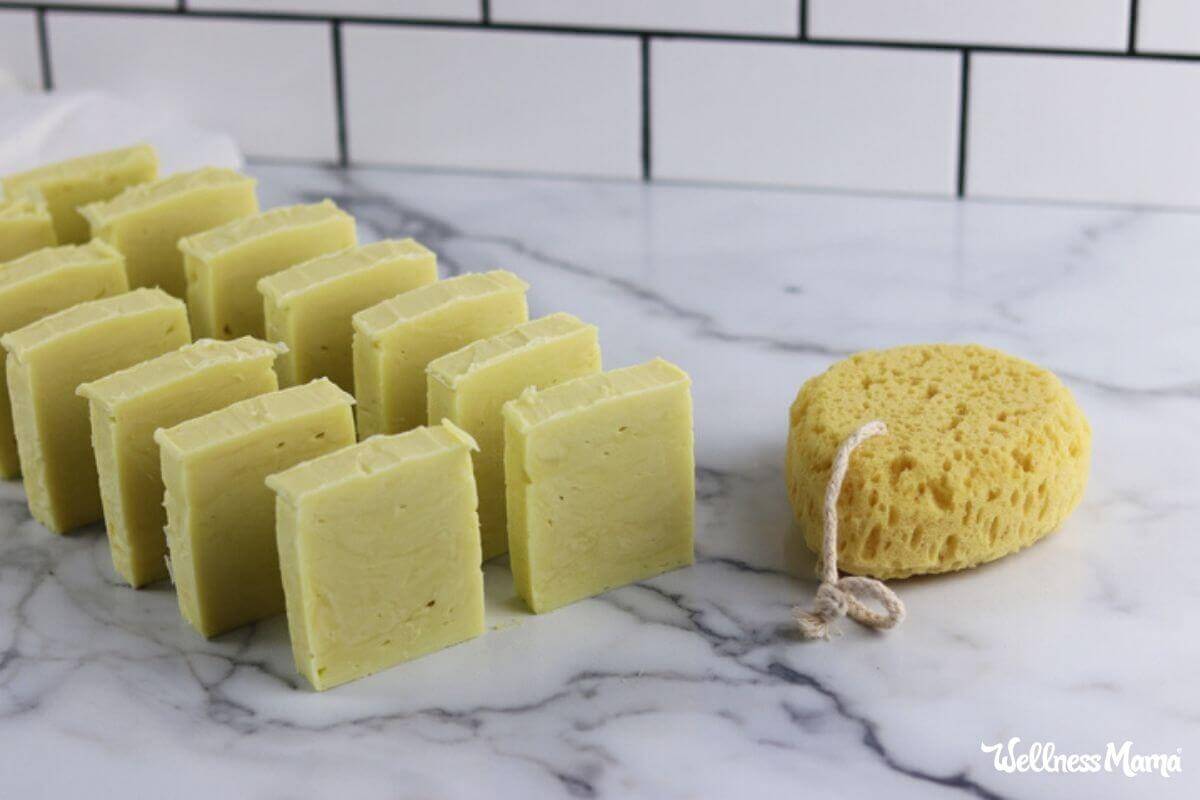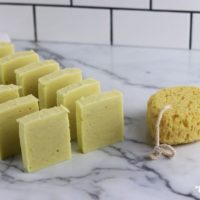As the long-term effects of antibacterial soaps become more widely known, people are turning to more natural alternatives. This movement has resurrected the art of soap making. If you are new to making soap you are in for a real treat! It can seem like a daunting undertaking at first but it is such a rewarding process.
No farmer’s market would be complete without the beautiful array of homemade soaps. It is wonderful to support these local vendors but if the price-tag is out of reach for you, don’t despair. You can still ditch the antibacterial soaps by making your own homemade cold process soap!
How Is Soap Made?
Soap is a chemical reaction that occurs as a result of mixing an animal or vegetable fat with a base (sodium hydroxide). This chemical reaction is called saponification.
Merriam-Webster defines saponification as “the hydrolysis of a fat by an alkali with the formation of a soap and glycerol.” OK, so what does that mean?
Each fat has a unique combination of triglycerides. Triglycerides are compounds made up of a single molecule of glycerol and 3 fatty acids. Each combination requires a different amount of alkali to complete the saponification process. The alkali in soap-making is sodium hydroxide, also called lye.
The lye is mixed with water to create a basic solution. This solution is then mixed into your fats. As they are combined and begin to react, the glycerol molecule is separated from the fatty acids. The fatty acids then react with the hydroxide ions in the lye solution. This is saponification.
The two resulting products of the saponification process are glycerin, which is wonderfully moisturizing for the skin, and soap. No lye remains as it has all reacted with the fats to create a completely new substance.
Worried About Lye?
As I covered in-depth in this post, it isn’t truly possible to make soap without lye in some part of the process. Lye is the necessary agent for saponification and any true soap, even one you buy, is made with it. You can purchase a pre-made soap base but it is much less budget friendly.
Cold Process Soap vs. Hot Process Soap
The method you choose is a matter of personal preference. This post is to teach you about cold process soap but you can take the same recipe and use the hot process method instead.
Both of these methods begin in the same way. You make a lye/water solution and mix it with the oils to begin saponification. To make a cold process soap you would incorporate any additives and pour it into the mold as soon as it reached trace (more about trace later).
For hot process soap you would let the soap batter “cook” in a slow cooker on the lowest heat to accelerate and complete saponification. Then you would stir in your additives and mold it.
Cold process soap takes 4-6 weeks to completely saponify and be ready to use. In theory, hot process is ready to use immediately. However, it is wise to let it sit a week or so to harden a bit. This will make it last considerably longer.
I have made soap both ways and I like each method for different reasons. Cold process soap is easier to pour into the molds so if you are trying to use a mold with a design or pattern I would recommend cold process.
I like hot process for my everyday soaps (especially because I don’t always get them made on time, *ahem*), so it is great if I am in a pinch and need soap, like, yesterday.
Both methods are great and in the end you get the same result, soap! If you would like to try hot process you can try my recipe for basic slow cooker soap.
Ingredients for Making Soap
The most basic ingredients you will need are water (distilled is best), lye (sodium hydroxide), and some type of animal or vegetable fat (such as olive oil or tallow). These three ingredients are essential and it is wise to use a lye calculator to accurately determine the ratios needed for proper saponification.
There are countless combinations of oils you can come up with for a soap recipe. Each fat or oil has it’s own impact on your finished product. Some are great cleansers while others are more gentle and moisturizing. Some make large bubbles as opposed to others that create a low lather.
You can use all of one type of oil or a mixture of several different ones. A pure olive oil soap, also called castile soap named for a region in Spain, makes a very gentle bar of soap. A pure tallow soap has high cleansing ability and makes a great laundry bar.
I personally like to use at least two different oils to give the soap a bit more character. With a blend of oils it is much easier to achieve the qualities you are desiring in a soap.
Some of the most popular soaping oils are:
- coconut oil
- olive oil
- castor oil
- cocoa butter
- mango butter
- sunflower oil
- sweet almond oil
- jojoba oil
If this will be your first time making soap, a good place to start would be to use olive oil, coconut oil, and castor oil. This combination will give you a mild soap with a good lather and these oils are easy to come by. We will use these oils in the instructions below.
Optional ingredients can be added to customize your soap recipe. Essential oils added after trace are a natural option for giving your soap a lovely scent. Clays add a silkiness to the soap that is especially good for shaving. Sea salt soap (do not use dead sea salt) is exfoliating and detoxifying.
Ground coffee, oatmeal, and botanicals like dried lavender flowers or herbs give a nice texture to the soap. For a natural colorant you can try adding mica powders, cocoa powder, turmeric, or spirulina.
As you learn more about soap making you can even experiment with alternate liquids such as goat milk, herbal tea, or even beer.
Working With Lye
Lye is used to make all soap. Even melt and pour soap bases were originally made with lye. There is a common misconception that soap is not natural or healthy if it is made with lye. This simply isn’t true. It is necessary to use lye to achieve the chemical reaction, but you can be assured that when done correctly, no lye remains.
In fact, most soap is “super-fatted.” This means that there is extra fat worked into the recipe so that there is no possibility that any lye will remain. This also makes the bar more moisturizing. A good rule is to superfat by 5%.
I would guess that working with lye is the greatest deterrent for people who are thinking about making soap. I can understand how this would be a stumbling block but if you know and follow proper safety measures, you shouldn’t have any problems working with it.
Lye safety measures
- Wait until children are in bed. Making soap is not an activity to do with children. Watch out for pets as well. Children and pets can cause distractions or spills.
- Wear long sleeves and protective gear including safety glasses and rubber gloves.
- Make sure your workspace is free of clutter that could cause a spill. Also, remove anything that could be ruined if a spill were to happen.
- When the lye and water are mixed it will create fumes. Do this step in a well-ventilated area or even outside. I prefer to do it outside so I have no concern about fumes and then if I were to spill (I haven’t yet) it would not be in my house.
- Always add lye to the water. DO NOT add water to lye. It will create a caustic eruption! The adage in the soaping world is “snow floats on the lake.” It MUST be done in this order.
Hopefully these safety tips serve to make you feel more comfortable working with lye. The first time is a bit nerve-wracking but once you have done it you will see that it is not so frightening!
Cold Process Soap Making
Now that we’ve got those little details out of the way, let’s get into the nitty gritty of soap making, and more specifically, the cold process method!
Soap Making Supplies
I have a set of tools I keep just for soap-making. It is not absolutely necessary to keep them separate but it eliminates any possibility of not getting your tools clean enough for food preparation.
- Non-reactive pot or slow-cooker for warming oils
- Heavy plastic pitcher or quart mason jar for mixing lye/water
- Second jar or disposable cup for measuring lye
- Infrared thermometer or 2 candy thermometers
- Mold (this one will fit this recipe)
- Digital scale
- Stick blender
- Spoon
- Spatula
- Safety glasses and rubber gloves
- Lye – I have purchased lye online and also at a local hardware store. (Try a smaller store as the large chain stores do not typically carry it.) You will have to ask an employee for it.
- White vinegar for final cleanup
Basic Cold Process Soap Recipe
Equipment
Materials
- 30 oz olive oil
- 6 oz coconut oil
- 2 oz castor oil
- 5.09 oz lye
- 12.54 oz distilled water
- 1 oz essential oils (such as peppermint or orange, optional)
Instructions
- Prepare your mold. Wood molds will need to be lined with freezer paper or wax paper. Silicone molds are ready to use as is. You can also use any box if you line it with freezer paper, wax paper, or a thick garbage bag.
- Put on protective gear, place a glass jar on the scale, and tare the scale.
- Pour distilled water into the jar until it reads 12.54 oz.
- Set aside.
- Put a second jar on the scale and tare the scale.
- Carefully pour lye into the second jar until the scale reads 5.09 oz.
- In a well-ventilated area or outside, slowly pour the lye into the water.
- Stir the mixture until the lye is dissolved. It will become quite hot so be careful if you need to move it.
- Let this mixture sit and cool to between 100-120°F.
- While the lye is cooling, measure all other ingredients EXCEPT the essential oils and warm them together in a pot or slow-cooker.
- Once they are melted, remove them from the heat and let cool to between 100-120 degrees. I use the infrared thermometer about every 5-10 minutes to test the temperature. This works really well, but a candy thermometer placed in each container also works. If one is cooling faster than the other you can put your oils back on the heat source or the lye/water mixture in a warm water bath to slow the cooling process a bit. Ideally, you want the lye/water and the oils to both be between 100-120 degrees and within 10 degrees of each other.
- When the temps match, slowly pour the lye/water into the oils.
- BEFORE you turn your stick blender on, make sure the blade is completely under the mixture or you will splash it everywhere. Use the stick blender to bring the batter to a light trace. It should be slightly thick and resemble cake batter.
- If using, add the essential oils now.
- Blend essential oils in by pulsing the immersion blender a few times. This should bring the mixture to a medium trace. You can tell when you have reached a medium trace by lifting your blender up out of the mixture (in the OFF position) and observing how the drips behave. They should leave a trail or “trace” on the surface. If you don’t use essential oils, just pulse your blender a few more times to bring it to medium trace.
- Pour the soap batter into your prepared mold, using a spatula to get it all out. Remember that the soap is not fully “cooked” yet at this point and could still irritate your skin so you should still be wearing your gear.
- Put the mold somewhere it can sit for 24 hours.
- Place an upside down cardboard box over the soap and cover with a towel. If your house is warm the towel may not be necessary.
- Let sit for 24 hours.
- You can now remove your soap and cut it. This recipe in the silicone loaf mold makes about 12 bars weighing approximately 4.5 oz each, but you can cut them whatever size you like.
- Stand the bars up in a dry area with an inch or so of space in between to allow for air circulation and let them sit for 4-6 weeks. This will allow the soap to complete the saponification process. The soap will also lose some of its water during this time making the bar harder. The harder the bar, the longer it will last.
Notes
Rinse the jars and any supplies that had lye or soap batter in them well, with running water. I have washed the tools two different ways. You can pour some vinegar in a sink filled with hot soapy water and wash them in there, or you can wash your well rinsed dishes in the dishwasher.
A Note About “Trace”
Most soap recipes tell you to blend the lye/water and oils together until you reach trace. What this means is that you will need to blend until there is no separation left in the mixture. If the lye/water and oils are not completely mixed, your oil will separate in the mold and leave pockets of lye.
When your mixture has reached a light trace it will resemble cake batter. A medium trace is more like pudding but still pourable, and a thick trace holds its shape. When you have gone as far as a thick trace, your soap will likely have to be spooned into the mold.
Have you made your own soap? Share your favorite recipe!




Leave a Reply